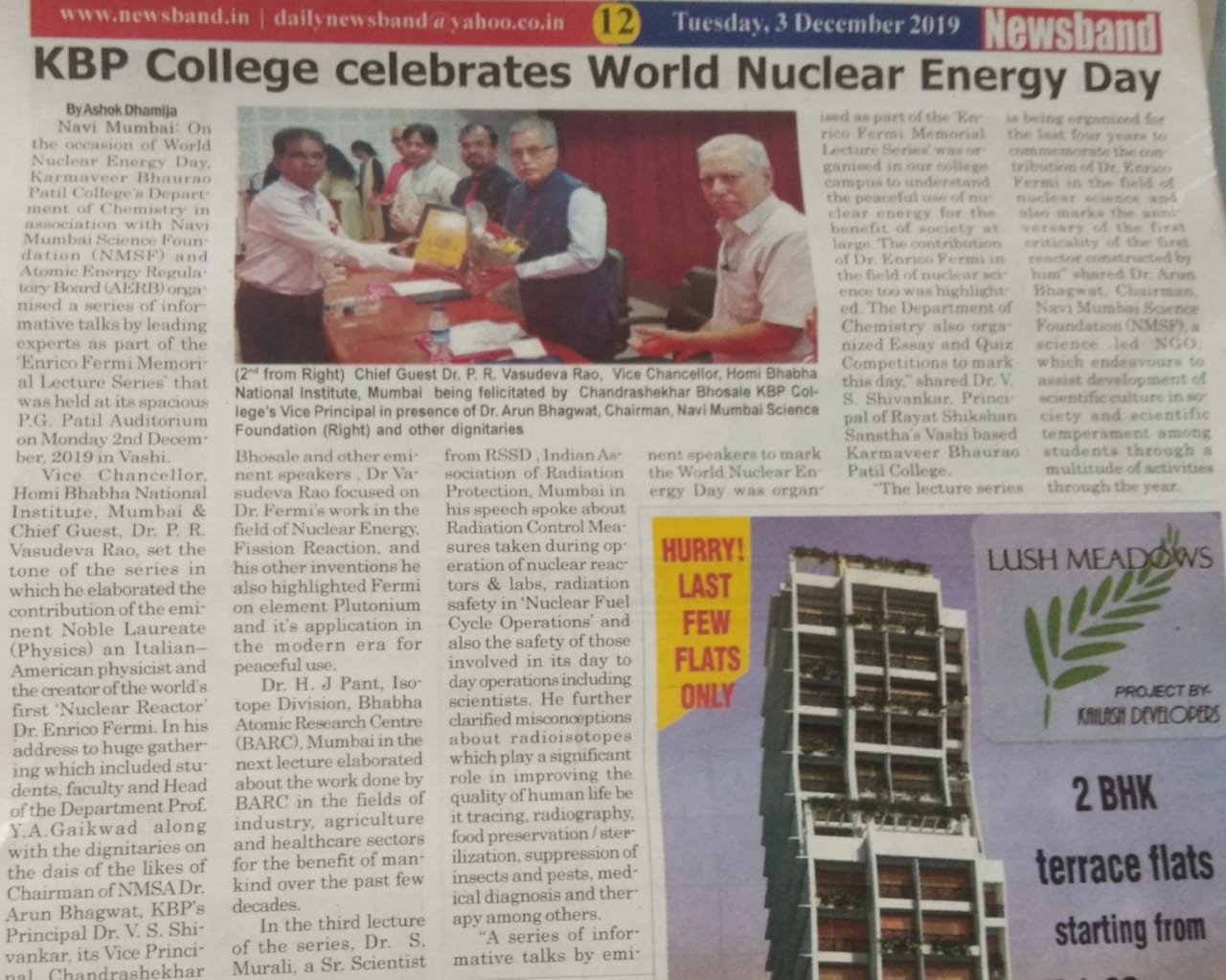
World Nuclear Energy Day 2020Date: 2nd of Dec., 2020. Venue : Online Google Meet World Nuclear Energy Day (WNED) was celebrated jointly by Navi Mumbai Science Foundation and Karmaveer Bhaurao Patil College (KBPC), Vashi, on 2nd December 2020, online via Google Meet. A commemoration of the first criticality of Enrico Fermi's Nuclear reactor (Chicago pile) on the same date in 1942, Scientists from Department of Atomic Energy discuss various aspects of Nuclear energy as it stands today for the benefit of college students.
Chief Guest: Hon. Prof. B. N. Jagtap Dept. of Physics, IIT, Mumbai
All are welcome. Below is the link for joining the meeting (copy paste)
|
Program WNED 2020

|
World Nuclear Energy Day 2019
Dates: 2nd of Dec., 2019. Venue : K.B.P. College, Vashi.
World Nuclear Energy Day (WNED) was celebrated jointly by Navi Mumbai Science Foundation and Karmaveer Bhaurao Patil College (KBPC), Vashi, on 2nd December 2019, in association with Atomic Energy Regulatory Board (AERB),at KBPC premises at Navi Mumbai. It was to commemorate the anniversary of criticality achieved at the first reactor constructed by Famous American Scientist Enrico Fermi. The program started by lighting of sacred lamp and offering of floral tributes by all the dignitaries to the Founder of Rayat Shikshan Sanstha,Late Padmabhushan Shri Karmaveer Bhaurao Patil, as KBPC is part of this Sanstha. All the dignitaries on the dais were then felicitated by the college staff.

The programme started with introductory remarks made by Vice Principal, Shri Chandrasekhar Bhosale, about the significance of World Nuclear Energy Day (WNED)programme. Dr. D A R Babu, Secretary, NMSF, spoke about the importance of WNED programme,and also briefed the audience about the educational activities conducted by NMSF.He then introduced the Chief Guest,Dr. P. R. Vasudeva Rao, Vice Chancellor, Homi Bhabha National Institute (HBNI), and invited him to deliverthe “Enrico Fermi Memorial Lecture”.

Dr. Vasudeva Rao, Vice Chancellor, HBNI delivered his talk on 'Plutonium: A unique element'. In his introductory remarks about Fermi, he cited that No one in the history of modern physics was more versatile than Fermi and his contributions in theoretical and experimental physics work were equally great". The appearance of Fermi's name in physics terminology under several heads, viz: Fermi-Dirac statistics,Fermion, Fermi gas, Fermi length, Fermi level, Fermium etc., are worth mentioning. He was an excellent teacher and team leader to set up the first Chicago pile-1, where controlled nuclear chain reaction was successfully demonstrated on 2, December 1942. This finally culminated in initiating the new age of nuclear energy (it may however be noted that Fermi received the Nobel Prize in Physics in 1938 "for his demonstrations of the existence of new radioactive elements produced by neutron irradiation, and for his related discovery of nuclear reactions brought about by slow neutrons"). Fermi's contributions in the field of physics were subsequently reflected in form of Noble Prizes received by his associates/students in the subsequent years.
Dr. H. J. Pant of Isotope and Radiation Applications Division, BARC delivered the talk of the day referred to applications of radioisotopes for the benefit of humankind.
Radiotracers have been widely used in environment for troubleshooting and generation of useful information because of their many advantages over conventional tracers. The main advantages of radiotracers are physico-chemical compatibility, high detection sensitivity, in-situ detection & availability of a number of radiotracers for different phases; the radioactive material in a suitable physico-chemical form similar to that of the process material is instantaneously injected into the system at a suitable point and its passage is monitored along the system at strategically selected locations using collimated radiation detectors. The monitored tracer concentration data is plotted as a function of time and interpreted to obtain information about the process or hydrodynamic behavior of the system. • Leak detection in buried pipeline and industrial systems &its environmental implications • Flow rate measurements in streams & rivers • Sediment transport investigations in ports • Effluent dispersion studies in water bodies • Radiotracer applications in oil field investigations • Seepage studies & underground water movement Since early sixties, Bhabha Atomic Research Centre (BARC), Mumbai has made pioneering contribution to the development and promotion of radiotracer technology in India and Asia Pacific region for several environmental investigations. Radiation Safety in DAE facilities:
Dr. Murali Seshadri of Radiation Safety Systems Division, BARC unlighted the participants about the safety culture in DAE. He explained about complete organizational chart of DAE. He mentioned how AERB is regulating and maintaining the excellent safety culture in all non DAE (nuclear power plants) and non DAE facilities. In view of present scenario, where radio-isotope applications are increased considerably, his presentation was appropriate for this event. He also mentioned about radiation safety implementation in BARC facilities by BSC.
Shri Shri Swapnesh Kumar Malhotra, Secretary, Atomic Energy Education society and former Head, Public Awareness Division, BARC spoke about "The Public Perceptions About Atomic Energy and Radiation". He used very lucid language and layman's language to explain how misplaced are the fears about atomic energy and radiation in the minds of general public. He used day-to-day examples to demystify the myths about nuclear industry. He debunked the fear of radiation and nuclear industry by comparing it with natural radioactivity and with conventional industry. He successfully convinced the audience that public exposure to the risks involved in conventional industry is far more compared to nuclear industry.
Dr. Murali Seshadri of Radiation Safety Systems Division, BARC highlighted the participants about the safety culture in DAE. He explained about complete organizational chart of DAE. He mentioned how AERB is regulating and maintaining the excellent safety culture in all non DAE (nuclear power plants) and non DAE facilities. In view of present scenario, where radio-isotope applications are increased considerably, his presentation was appropriate for this event. He also mentioned about radiation safety implementation in BARC facilities by BSC.




